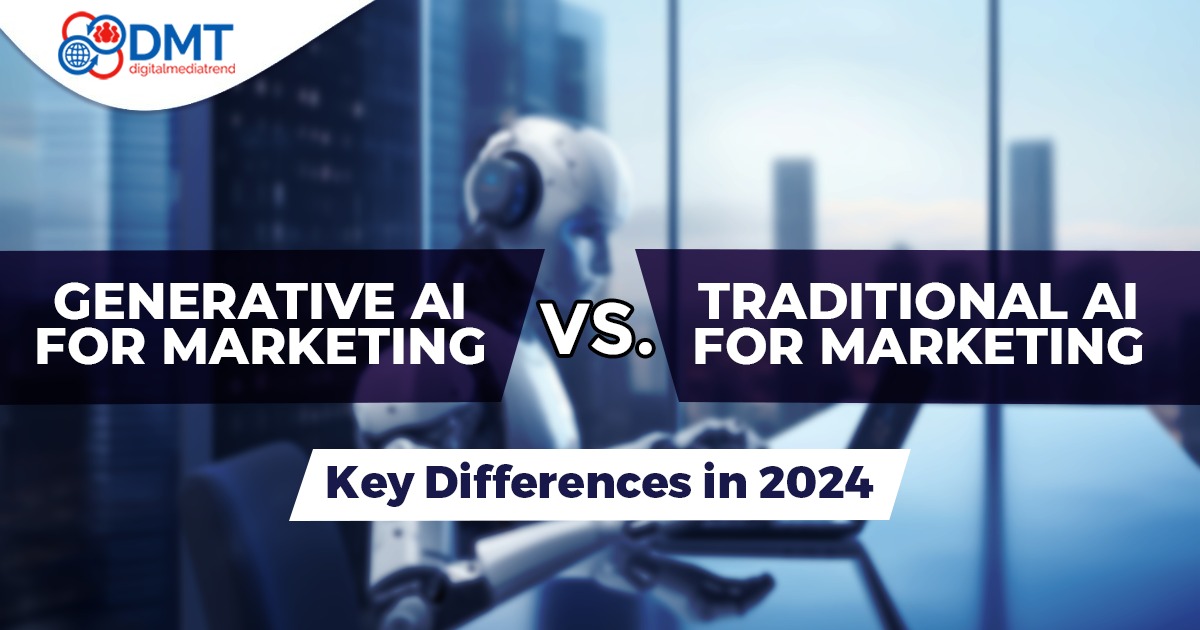In marketing, Traditional AI and Generative AI serve different functions and offer unique capabilities, though both contribute to improving efficiency and creativity. Here’s a comparison of the two:

- Purpose and Functionality
-
- Traditional AI: Primarily focuses on analyzing data, automating repetitive tasks, and enhancing decision-making processes. It can recognize patterns, predict trends, and optimize campaigns based on historical data.
- Example: AI-driven algorithms that optimize ad targeting by analyzing consumer behavior or automating customer service through chatbots.
- Generative AI: In contrast, generative AI goes beyond analysis to create entirely new content. It can generate text, images, videos, and even synthetic data based on prompts and training.
- Example: Tools like ChatGPT (for text) or DALL-E (for visuals) used to create marketing copy, design ads, or even generate personalized email content.
- Application in Marketing
-
- Traditional AI: Commonly used in automating and optimizing operational tasks like predictive analytics, programmatic advertising, recommendation engines, and segmenting audiences.
- Marketing Use Case: Traditional AI could analyze customer purchase history to predict future buying behavior and suggest relevant product recommendations.
- Generative AI: Focuses on creativity, enabling marketers to produce unique and personalized content at scale. This can involve creating tailored messages for customer segments or generating multiple ad variations.
- Marketing Use Case: Generative AI can create various versions of ad copy or visual elements to appeal to different audiences without manual intervention.
- Creativity vs. Automation
-
- Traditional AI: Primarily excels in automation and operational efficiency. It takes on repetitive, data-heavy tasks, often without much creative input.
- Example: Automating A/B testing for campaigns, where the AI adjusts parameters to identify what works best over time.
- Generative AI: Emphasizes creativity by producing original content based on training data. It enhances a marketer’s ability to generate creative assets more quickly and efficiently.
- Example: Writing personalized product descriptions or creating new ad visuals tailored to individual customer preferences.
- User Control and Involvement
-
- Traditional AI: Operates within a fixed set of parameters, relying heavily on past data. Users maintain more control, as AI suggests decisions based on predefined goals or historical outcomes.
- Example: Optimizing Facebook Ads campaigns based on previous results from similar audiences.
- Generative AI: More dynamic and capable of working with less structured input. It can create novel content with minimal guidance, often surprising users with new ideas.
- Example: Generating unique social media posts for different marketing campaigns, inspired by trends or past performance but not limited to them.
- Use of Data
-
- Traditional AI: Focuses on analyzing structured and historical data to forecast trends, segment audiences, and optimize performance.
- Example: Using customer relationship management (CRM) data to enhance lead scoring and improve personalized email campaigns.
- Generative AI: Works on both structured and unstructured data to create new outputs, often relying on machine learning models trained on large datasets like text, images, or videos.
- Example: Using generative models to create new product images for e-commerce platforms.
-
- Traditional AI: Best for automation, optimization, and decision-making based on data.
- Generative AI: Focused on creativity and content generation, allowing for more personalized, dynamic marketing efforts.
Marketers can use both types of AI in tandem—Traditional AI for improving operational efficiency and Generative AI for elevating creativity.

